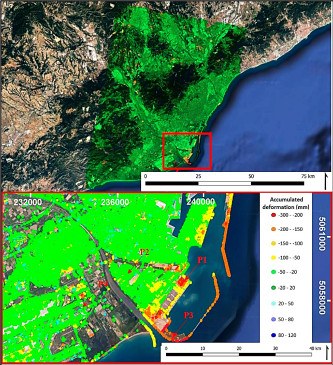Vrinda Krishnakumar defended her thesis on the exploitation of the PSInSAR technique with Sentinel-1 data for the measurement of ground movements
Oct 04, 2022
Vrinda Krishnakumar defended her thesis directed by Dr. Oriol Monserrat on September 29. The defense was online. Entitled "Sentinel-1 data exploitation for terrain deformation monitoring", the thesis presents a series of diverse approaches to the PSInSAR technique focused on the maximum use of the characteristics of Sentinel-1 SAR satellites for the measurement of terrain movements
Persistent Scatterer interferometry (PSI) is a group of advanced differential interferometric Synthetic Aperture Radar (SAR) techniques used to measure and monitor terrain deformation. Sentinel-1 has improved the data acquisition throughout and, compared to previous sensors, increased considerably the Differential Interferometric SAR (DInSAR) and PSI deformation monitoring potential. The effect of the refractive atmosphere on the interferometric phase and phase unwrapping ambiguity are two critical issues of InSAR. The low density of Persistent Scatterer (PS) in non-urban areas, another critical issue, has inspired the development of alternative approaches and refinement of the PS chains. This paper describes a method for atmospheric phase screen estimation using rain station weather data and three different data driven procedures to obtain terrain deformation maps. These approaches aim to exploit Sentinel-1 highly coherent interferograms and their short revisit time. The first method called the spectrum splitting makes uses of the power spectrum of the interferograms to split the signals into high and low frequency and following a mutually exclusive consecutive processing chain for the two sets. This approach has resulted in greater density of PSs with decreased phase unwrapping errors. The second approach, called Direct Integration (DI), aims at providing a very fast and straightforward approach to screen wide areas and easily detect active areas. This approach fully exploits the coherent interferograms from the consecutive images provided by Sentinel-1 resulting in a very high sampling density. However, it lacks robustness and its usability lays on the operator experience. The third method, called PSIG (Persistent Scatterer Interferometry Geomatics) short temporal baseline, provides a constrained application of the PSIG chain, the CTTC approach to the PSI. It uses short temporal baseline interferograms and do not assume any deformation model for point selection. It is also quite a straightforward approach and a perfect complement to the direct integration approach. It improves the performances of the standard PSIG approach, increasing the PS density and providing robust measurements. The effectiveness of the approaches is illustrated through analyses performed on different test sites.

Share: